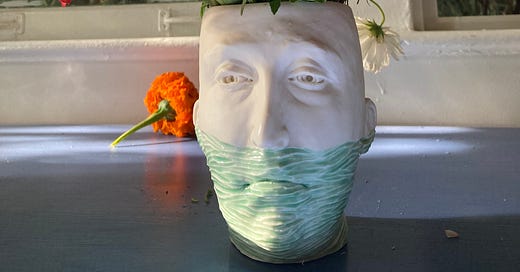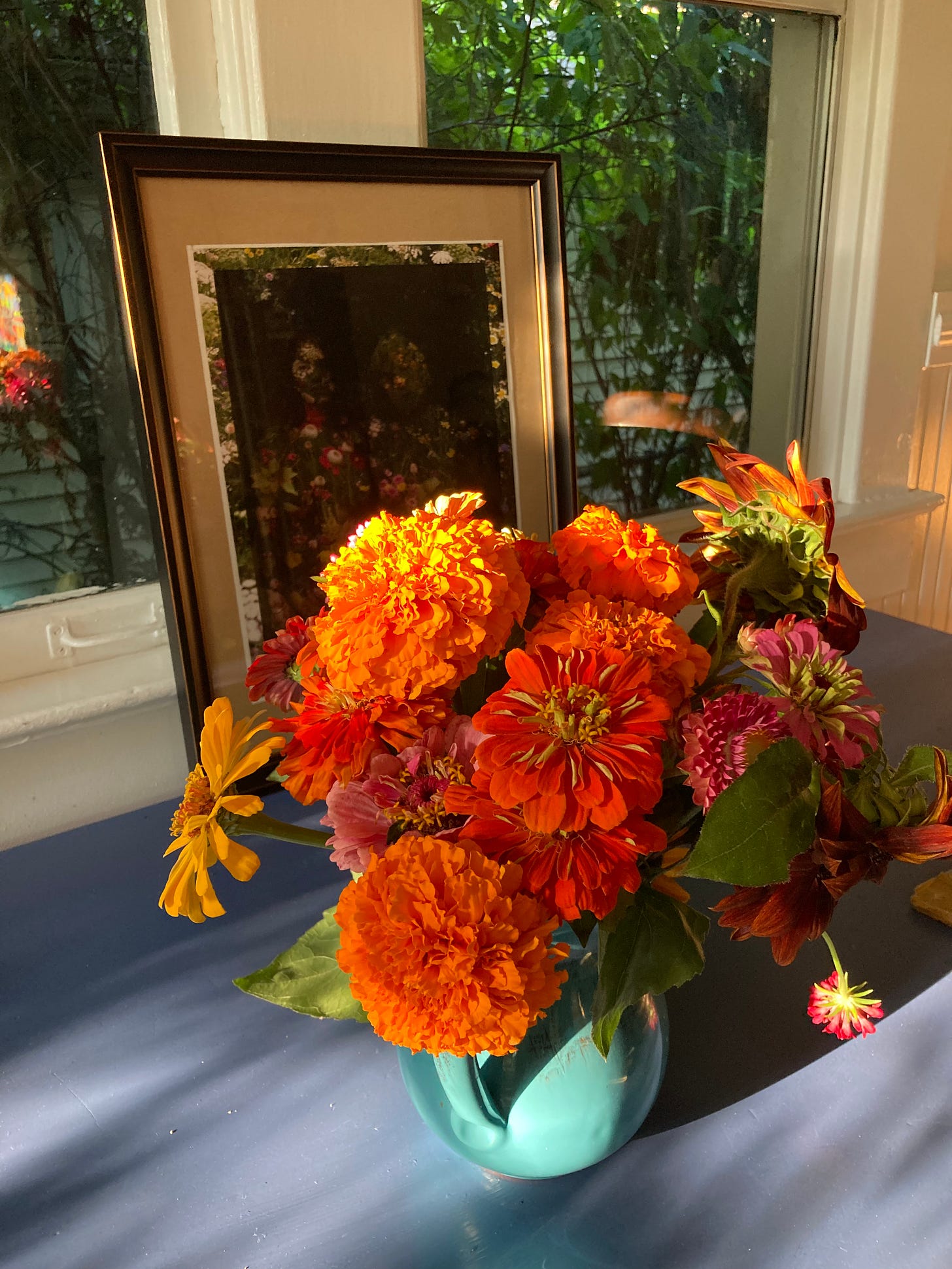I am a person who has chosen beauty.
These words keep coming into my mind all summer, when I looked at the bouquets of flowers from my CSA — all reds and oranges and pinks, marigolds and zinnias, sunflowers and straw flowers — on the table my mom found for me on the side of the road and that I painted blue.
One week, I put the flowers (carefully) into the vase made by sculptor and friend Adrian Arleo, one of her small works from the pandemic art world freeze. I’ve been in awe of Adrian’s work since I first saw it almost twenty years ago. Looking at her work is like being in the wilderness, that deep kind of nourishment and slowness. It’s like being in the wilderness but also being in some deep human mind, that fairy tale familiarity, as if I’ve already seen the images in forgotten dreams. So. When she made a series of small, teacher-affordable works, I bought one for my 40th birthday. It was the first time I’d paid real money for real art and it felt like a new kind of choice. Mostly, the vase peers down from a high shelf in my kitchen, a tether down into the deep stuff next to the tea cups. But filled with flowers, it becomes something new.
This year, I have a new piece of art, that I was just framing and had leaned on the wall by the table. It’s a double exposure of two of Sian Davey’s photos from her latest project, The Garden. Sian was my neighbor when I sublet a room in a house in Devon in 2014, and has since been recognized widely and deservedly for her work. Her daughter is one of my daughter’s namesakes, and I’m just in general very inspired by her work and family. I would be so content to spend a real significant part of my life looking at her photography.
This piece is a mother and grown daughter superimposed with flowers and I love it. This time around, I didn’t even deliberate a day before buying it.
The flowers I picked, the table I painted, the art I chose.
I am a person who has chosen beauty.
Also there is clutter and moldy bags of unhulled walnuts and the floor/the house/my bed is full of sand maybe from A’s hair after her DIY mud spa at the river and I have a swollen sty on my eye and something is bothering my sinuses and it’s fruit fly season. I say all that so you know I don’t live in Instagram.
And when I say beauty, I don’t mean exactly Instagrammable beauty, though I do find purty pictures in my feed soothing and I did post a picture of these flowers. I don’t mean beauty out of context of everything else, or beauty as a performance of goodness. Though I also have the voices in my head that say beautiful home = person who is not a disaster.
I’d like to untangle that assumption. There’s a lot of class stuff there, and a lot of perfectionism AKA white supremacy. There’s white girl good girl stuff. Standard of beauty stuff. There’s the residue of me trying to belong in a small town as a bohemian lefty single mom who mostly wanted to read and plant flowers and whose kid was usually naked. There’s the unreal yardsticks, the keeping up with the Joneses and their Instagram feeds. This is all the ugly side of beauty. The way it can be a yardstick, applied from outside and inside, in service of a very narrow club.
But beauty also feels life-giving. I realized a long time ago how much energy I expend compensating when my living space doesn’t feel beautiful. Or in other words: beauty nourishes me. And spaces I make often reflects my inner state.
I am a person who has chosen beauty.
When I wrote my first novel, Good Like the Sea, the word beauty just kept appearing. It was a crutch, said people who gave me feedback. A vague word. A placeholder. What exactly did I mean?
Fair enough. I meant that harmonic pleasing rightness, that wholeness, that respect for more than usefulness, that holy pleasure, yes, that pleasing of senses and soul. In that book, it meant also a kind of slowness or listening, watching for the glimmer on the edges of perception, a subtle and receptive kind of aesthetics.
I am a person who has chosen beauty
Robin Wall Kimmerer asks, in her essay “Asters and Goldenrod,” why these two flowers, which look so pleasing next to each other, so often grow together.
“Why is the world so beautiful? It could so easily be otherwise: flowers could be ugly to us and still fulfill they’re own purpose. But they’re not.”
She was pushed away from this kind of question in the academic science world, and science’s aversion to this question is in a backward way why I care about beauty. It feels like a way of attending to what matters beyond power or profit or use. Because, while I love the curiosity of science, as well as so much of the learning it brings to light, I also have the hunch that Rebecca Solnit is right when she says that “science is how capitalism knows the world.”
I want the ineffable, the immeasurable, the pleasing. I want to honor my own sense of harmony. I want the kind of beauty that is alive and life-giving.
It is when we ignore our sense of beauty that we can do things like pave paradise.
Sometimes there’s an idea that floats around, particularly in radical spaces I pass through, that beauty is a privilege. Personally, I think that’s dreaming small. I think that beauty and life and meaning are all mixed up together, and that beauty is part of our flourishing, our mutual liberation.
Deep winter in this country, this is more true than ever. Attending to the slow listening glimmers, the exuberant excess of soul color, the nourishment of aesthetics: this is a way both to weather and to resist. To make what we can make sustain humanity. To do this for ourselves but also other people and the planet. It isn’t the only thing that matters, certainly, but it’s one thing.





